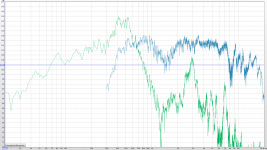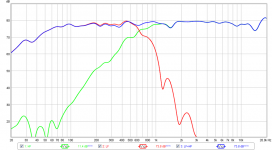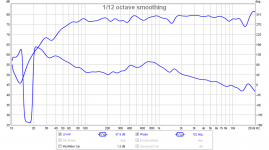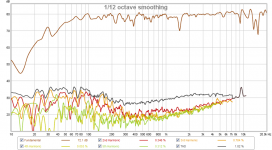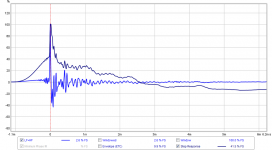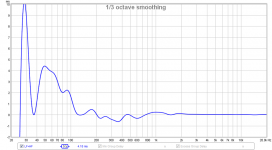The distortion is from the tweeter, though, not the midrange (whch goes down to 300Hz and can be seen to be reasonably comfortable)... CDX1-1445 really doesn't like pushing below 2kHz. So, first I'll try with the Tymphany tweeter and see how that does.
Doing woofers both above and below would start to give them directivity vertically (the distance from woofer to woofer starts to get significant) not meeting with the SEOS which loses vertical pattern pretty early. Woofers on just one side drops the spacing to just woofer-to-midrange. More important for these particular speakers, it would require twice the box volume again!
Doing woofers both above and below would start to give them directivity vertically (the distance from woofer to woofer starts to get significant) not meeting with the SEOS which loses vertical pattern pretty early. Woofers on just one side drops the spacing to just woofer-to-midrange. More important for these particular speakers, it would require twice the box volume again!
Last edited:
This is very interesting. I proposed using the seos waveguides a couple of years ago as synergy horns and got poo pooed... Glad to see someone actually doing it.
This is very interesting. I proposed using the seos waveguides a couple of years ago as synergy horns and got poo pooed... Glad to see someone actually doing it.
Well, if from a manufacturing point of view, a 19" synergy waveguide for the same box size would get almost the same lower pattern control frequency as this scheme with the spaced woofers. It would just be harder to build out of wood (and would probably need a bit more box volume to make up for the waveguide volume), so all I'm really accomplishing is an easier to DIY design that is a little smaller. MAYBE the SEOS throat and shape would be better for diffraction, but I'm kind of losing some of that anyway by using an inset baffle for a grille (I'm not all that sold on the diffraction-is-the-worst-evil thing😀).
Ok, I got my first speaker up and running. Still didn´t do stuffing, but it sounds nice.
Here are the details:
Horn: P.Audio 4528
CD FaitalPro HF206
Mids/Midbass: Two x P.Audio E8-150S V2
Two 25mm diameter taps for the mids. I forgot to measure the axial distance. When prototyping, I just tried a placement, and it worked. It´s exactly where there is a "seam" from the moulding process. Not too scientific. 🙂
It´s late here now, and I can´t redo the measurements, but what I can say is that the mids had a 10db hump in the upper end (measuring from about 30cm away). Moving the mike to very close to the taps, the hump disappeared, and it showed a nice bandpass response. So I figure the bump is because that´s where the horn/baffle stops loading the mids - lower than that and they are "on their own" so to speak.
In the box I showed in one of the previous posts, it seems 80hz is a natural place for a crossover. I would guess Q is a bit on the high side, with a mild hump at the bottom end.
Preliminary XO and EQ:
Mids: No highpass, LR24 @ 900, PEAK -10db Q2 @ 425,
Top: LR24 @ 600
I had a different alignment where I made less steep crossovers and just used a notch filter to remove the first reflection from the mids. I think I will go back to that once I can do some better measurements. Right now I just used a 24db/oct crossover to "get it done".
This probably doesn´t mean much to you without some measurements. I will get to them, but I need to do them properly first. Then of course the info above will change too.
The CD in this horn is ragged on the top end. I can´t hear it, but that´s perhaps since I can´t compare to anything not ragged right now. But the speaker as it is now sounds very effortless and articulated.
As for levels, the CD is about 12db more sensitive than the two mids combined (wired in parallel). It´s 109db (1w/1m) after all.
Without any delays there is a phase rotation, but earlier it was quite easy to get flat phase throughout the horns range by inverting/delay.
Here are the details:
Horn: P.Audio 4528
CD FaitalPro HF206
Mids/Midbass: Two x P.Audio E8-150S V2
Two 25mm diameter taps for the mids. I forgot to measure the axial distance. When prototyping, I just tried a placement, and it worked. It´s exactly where there is a "seam" from the moulding process. Not too scientific. 🙂
It´s late here now, and I can´t redo the measurements, but what I can say is that the mids had a 10db hump in the upper end (measuring from about 30cm away). Moving the mike to very close to the taps, the hump disappeared, and it showed a nice bandpass response. So I figure the bump is because that´s where the horn/baffle stops loading the mids - lower than that and they are "on their own" so to speak.
In the box I showed in one of the previous posts, it seems 80hz is a natural place for a crossover. I would guess Q is a bit on the high side, with a mild hump at the bottom end.
Preliminary XO and EQ:
Mids: No highpass, LR24 @ 900, PEAK -10db Q2 @ 425,
Top: LR24 @ 600
I had a different alignment where I made less steep crossovers and just used a notch filter to remove the first reflection from the mids. I think I will go back to that once I can do some better measurements. Right now I just used a 24db/oct crossover to "get it done".
This probably doesn´t mean much to you without some measurements. I will get to them, but I need to do them properly first. Then of course the info above will change too.
The CD in this horn is ragged on the top end. I can´t hear it, but that´s perhaps since I can´t compare to anything not ragged right now. But the speaker as it is now sounds very effortless and articulated.
As for levels, the CD is about 12db more sensitive than the two mids combined (wired in parallel). It´s 109db (1w/1m) after all.
Without any delays there is a phase rotation, but earlier it was quite easy to get flat phase throughout the horns range by inverting/delay.
I think I discovered the source of my high distortion and wonky SR. Over in this thread found out my new computer has built in SRS processing turned on by default. It applies a 10dB boost at 50Hz and 6dB cut at 300Hz.
I will have to re-measure these horns now that I found this. It may be a very different story indeed.
http://www.diyaudio.com/forums/full-range/292130-ff85wk-rs225-8-passive-fast-5.html#post4736469
I will have to re-measure these horns now that I found this. It may be a very different story indeed.
http://www.diyaudio.com/forums/full-range/292130-ff85wk-rs225-8-passive-fast-5.html#post4736469
I don´t know yet. I checked on a virgin horn - it´s still there, so it´s not the taps causing it. Perhaps it goes away when doing a more far-field measurement (it could be a cancellation from diffraction on the horn mouth that appears in the very near-field). I could try sticking the mike inside the horn and try too.
I don´t know yet. I checked on a virgin horn - it´s still there, so it´s not the taps causing it. Perhaps it goes away when doing a more far-field measurement (it could be a cancellation from diffraction on the horn mouth that appears in the very near-field). I could try sticking the mike inside the horn and try too.
It might be a reflection from the mouth if it's not mounted on a baffle with a round over.
xBUSH measurements outside of the Bermuda Triangle
I had a problem with my measurements for past months not looking right and it all seemed like I was in the Bermuda Triangle with all of these measurements that did not make sense.

I found the problem - it was a hidden SRS sound processor running in the background. Anyhow, all is right again and here are the new measurements.
I am using my new VHEX+ MOSFET class AB amp that I just built. Still going through miniDSP for EQ and XO. Fantastic sounding amp - very powerful and direct.
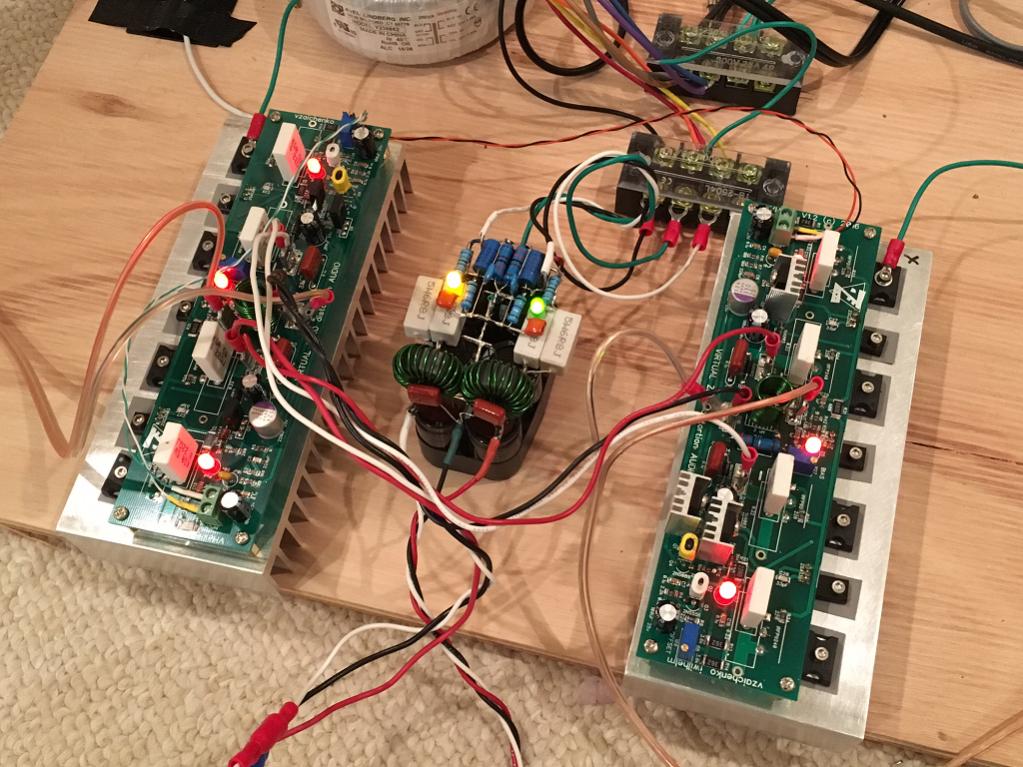
Here is the XO plot with 600Hz XO (BW4 LPF and BES2 HPF both at 600Hz electrical):
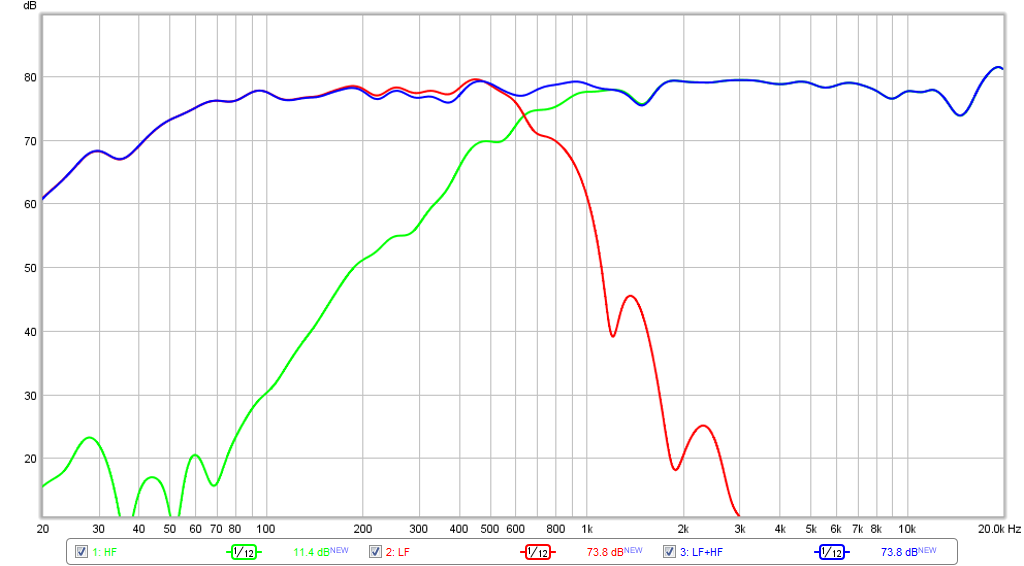
Here is the measured phase with the characteristic 55deg bump near the XO point, F3 is about 50Hz.
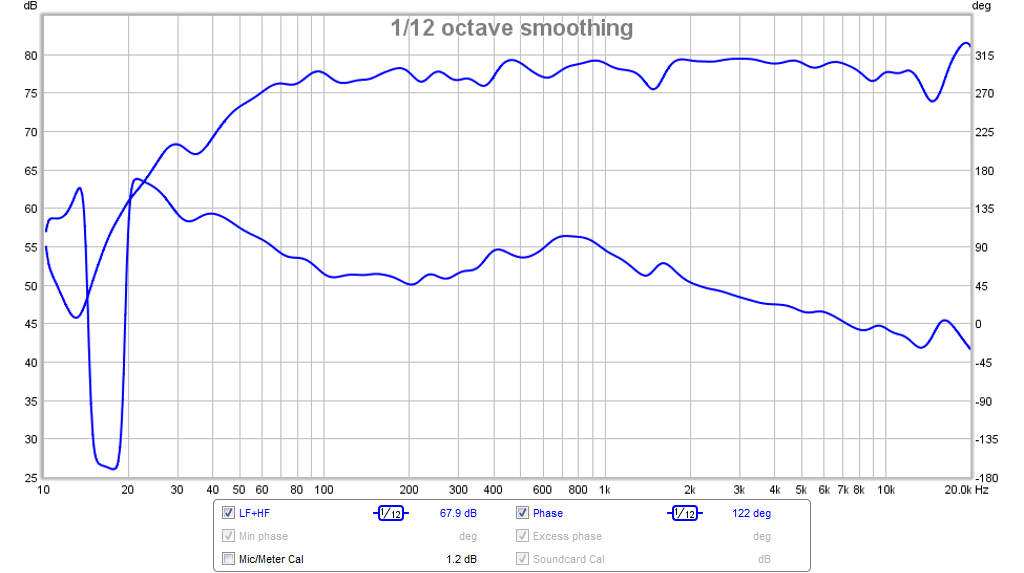
Here is the distortion:
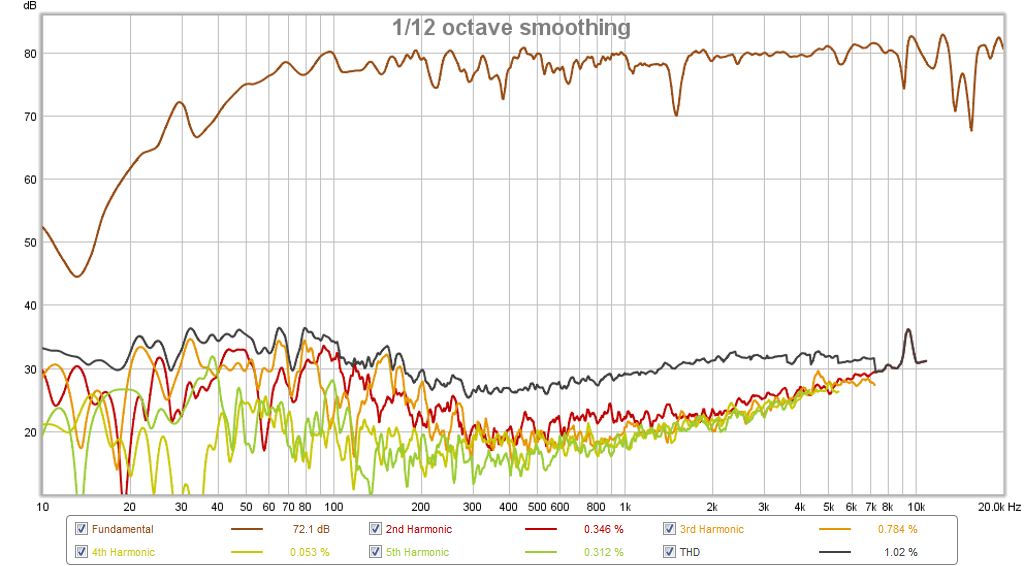
Here is the impulse and step response:
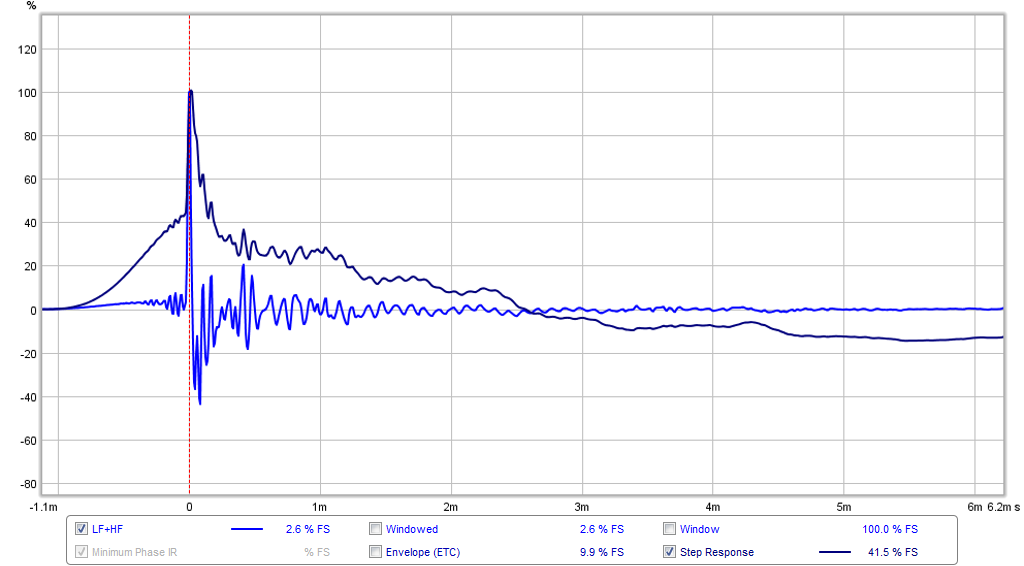
Here is the group delay with 1/3rd octave smoothing (all under 5ms above 40Hz):
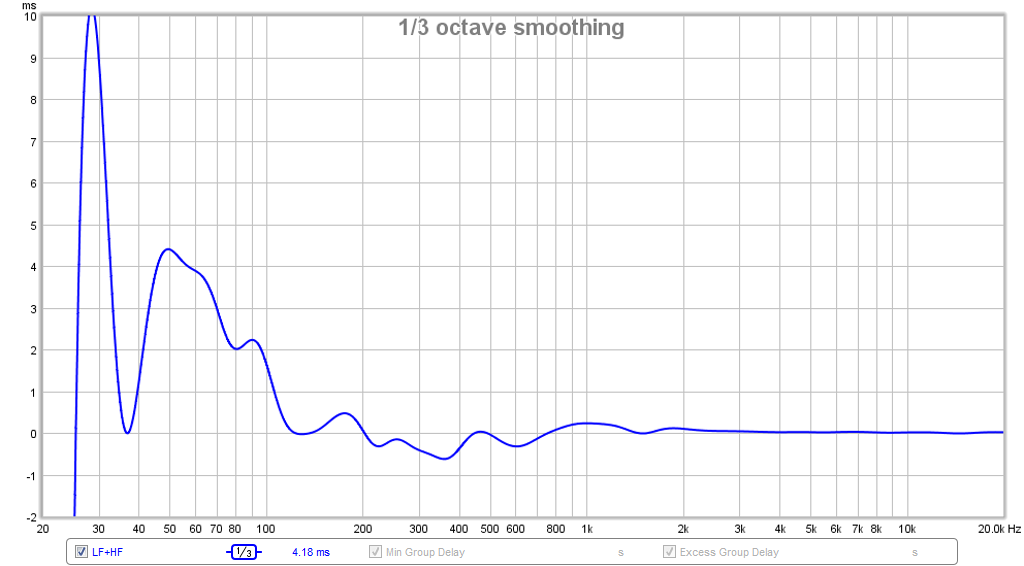
I am listening to it now and it sounds very nice. 🙂
I had a problem with my measurements for past months not looking right and it all seemed like I was in the Bermuda Triangle with all of these measurements that did not make sense.

I found the problem - it was a hidden SRS sound processor running in the background. Anyhow, all is right again and here are the new measurements.
I am using my new VHEX+ MOSFET class AB amp that I just built. Still going through miniDSP for EQ and XO. Fantastic sounding amp - very powerful and direct.

Here is the XO plot with 600Hz XO (BW4 LPF and BES2 HPF both at 600Hz electrical):

Here is the measured phase with the characteristic 55deg bump near the XO point, F3 is about 50Hz.

Here is the distortion:

Here is the impulse and step response:

Here is the group delay with 1/3rd octave smoothing (all under 5ms above 40Hz):

I am listening to it now and it sounds very nice. 🙂
Attachments
Last edited:
... I am using my new VHEX+ MOSFET class AB amp that I just built
Details ? I'm considering retiring my tube stuff for a little and making do with solid state while till the infant in the house learns to fear them 🙂 How do they compare with your class D stuff?
Thanks
Details ? I'm considering retiring my tube stuff for a little and making do with solid state while till the infant in the house learns to fear them 🙂 How do they compare with your class D stuff?
Thanks
My build is in this thread:
http://www.diyaudio.com/forums/soli...-amplifier-simulated-tina-32.html#post4729593
The amp PCB can be obtained here:
vzaudio
Since I have been building discrete transistor class AB amps I have been very impressed with how certain designs absolutely sound fantastic compared to my little class D amps. To be fair, this VHex is a 90w amp with four fat MOSFETs so the dynamic headroom and ease of playing bass with authority is obviously going to be better than a little amp whose size is smaller than one of the output transistors.
Here is my Apex FX8 in stereo:
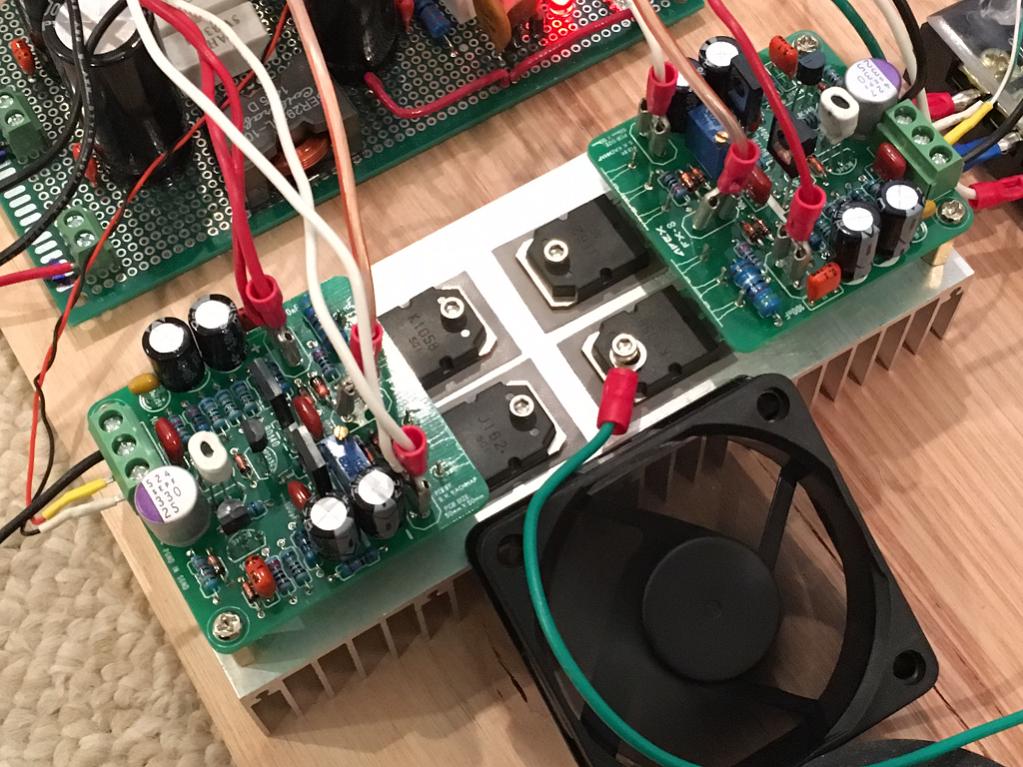
I can also highly recommend the Apex FX8, FH9, and the inverted JFET Circlotron.
Apex designs:
http://www.diyaudio.com/forums/solid-state/292226-directory-apex-audio-amplifiers.html
JFET Circlotron:
http://www.diyaudio.com/forums/solid-state/189599-my-little-cheap-circlophone.html
The mids and highs of the TPA3116 or TDA8932 or TDA7498 are all excellent - but they don't have as low of HD at 50w as the VHex amp (0.005% at 1khz 50w into 8R).
Subjectively, the biggest difference I hear is a tightness in the bass and ease of play - there is so much headroom the amp never sounds stressed. I can clip the 3116 but here I have to be careful about blowing the driver.
Last edited:
Very nice speaker and design there!
But I was just looking at this:
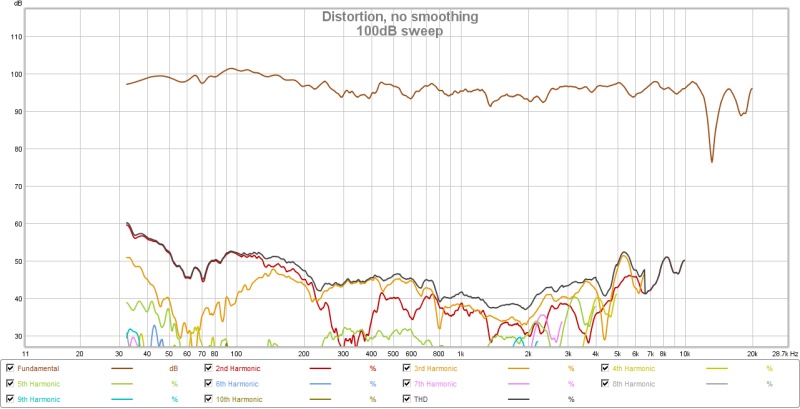
About 1% THD, at 35Hz at 100dBSPL? From two 8" woofers on a 15" horn? How is that even possible? Was it measured very close up?
But I was just looking at this:

About 1% THD, at 35Hz at 100dBSPL? From two 8" woofers on a 15" horn? How is that even possible? Was it measured very close up?
Hi, as you can see, the build was done in a few weeks of me pulling all nighters. I used sorbothane, extensive damping, solid oak bracing and magnet 'cradles' to reduce cabinet distortion.
The sb65 actually produces higher distortion than the sb23s, so that measurement is accurate. To be honest it was such a flurry of activity, building and measurements that I can't remember the exact distance for that, but the closest I did was 50cm, and judging from the slight downward tilt I think that was taken further out.
This was well within x-max for both woofers, and I think having them more or less opposing each other, combined with the cabinet details...it all helps.
The sb65 actually produces higher distortion than the sb23s, so that measurement is accurate. To be honest it was such a flurry of activity, building and measurements that I can't remember the exact distance for that, but the closest I did was 50cm, and judging from the slight downward tilt I think that was taken further out.
This was well within x-max for both woofers, and I think having them more or less opposing each other, combined with the cabinet details...it all helps.
Last edited:
Ok, well it checks out volume displacment-wise (17.12cubi inches at xmax) --
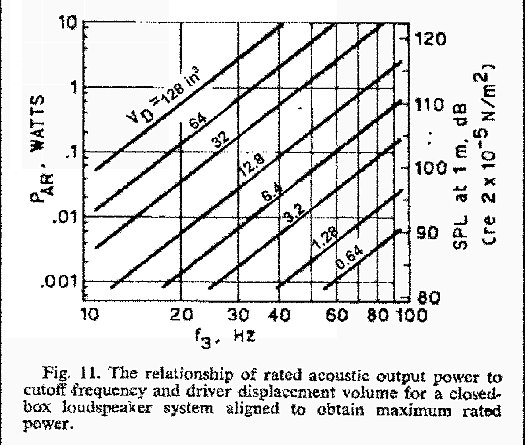
Pretty impressive to do that at 1% distortion. I'm going to have to start looking at SB drivers!

Pretty impressive to do that at 1% distortion. I'm going to have to start looking at SB drivers!
I have to be honest, it was entirely unexpected! I am still planning on using an 18 inch fane colossus from 100hz down, in a similar sized cube.....but only when WAF allows....
Bushmeister's xBush pretty much rocked the measurements and showed how woefully distorted most other dual 8in woofer designs are.
It's not interesting until the end when you see his room IS the horn. Cool and thanks for sharing.
It's not interesting until the end when you see his room IS the horn. Cool and thanks for sharing.
I more did point to the paper horn who he get away and then the change it did make.
- Home
- Loudspeakers
- Multi-Way
- A Bookshelf Multi-Way Point-Source Horn
